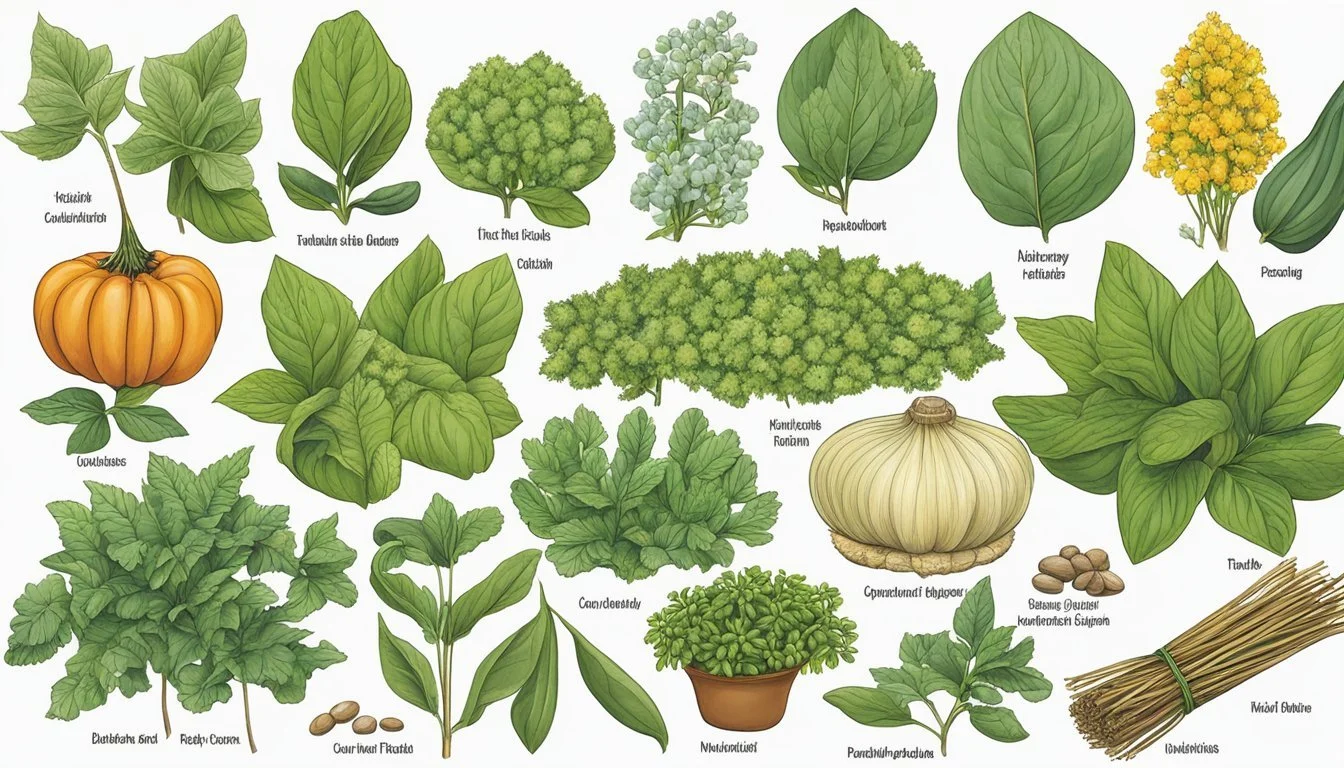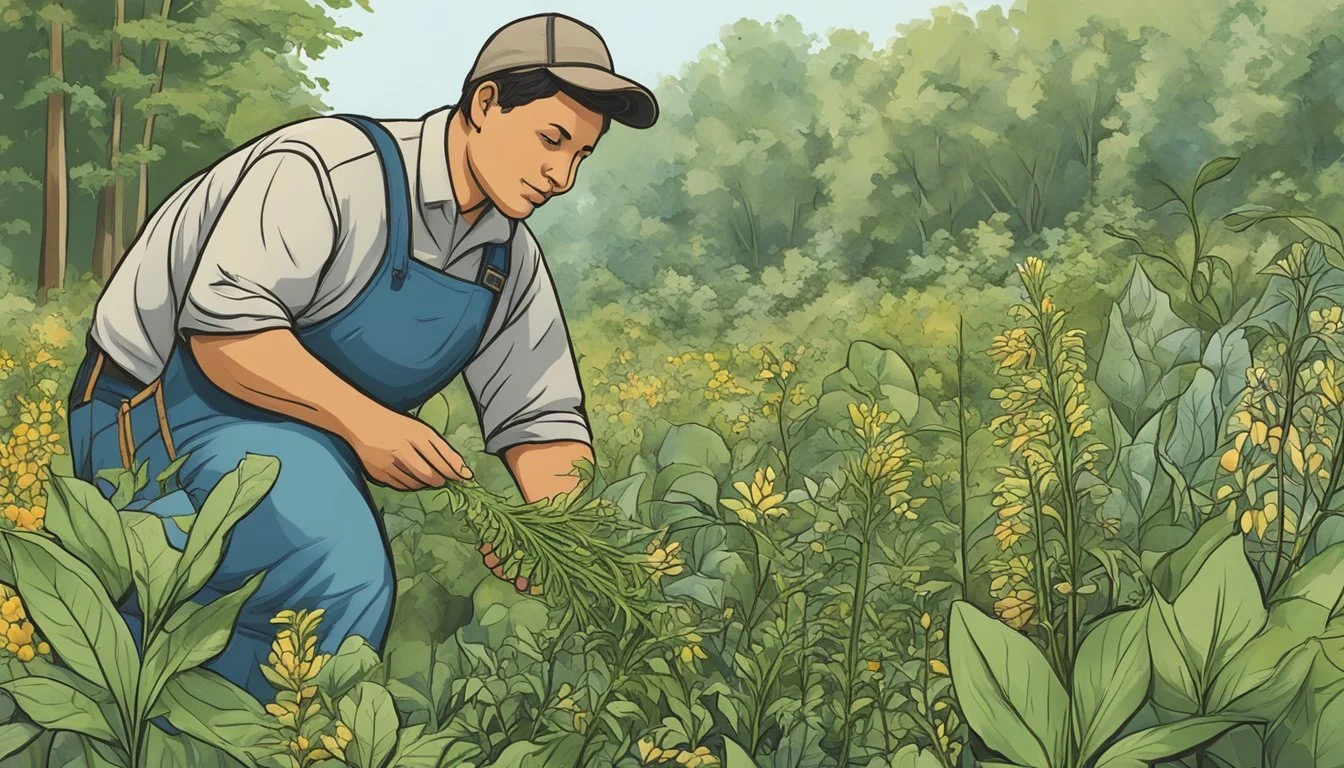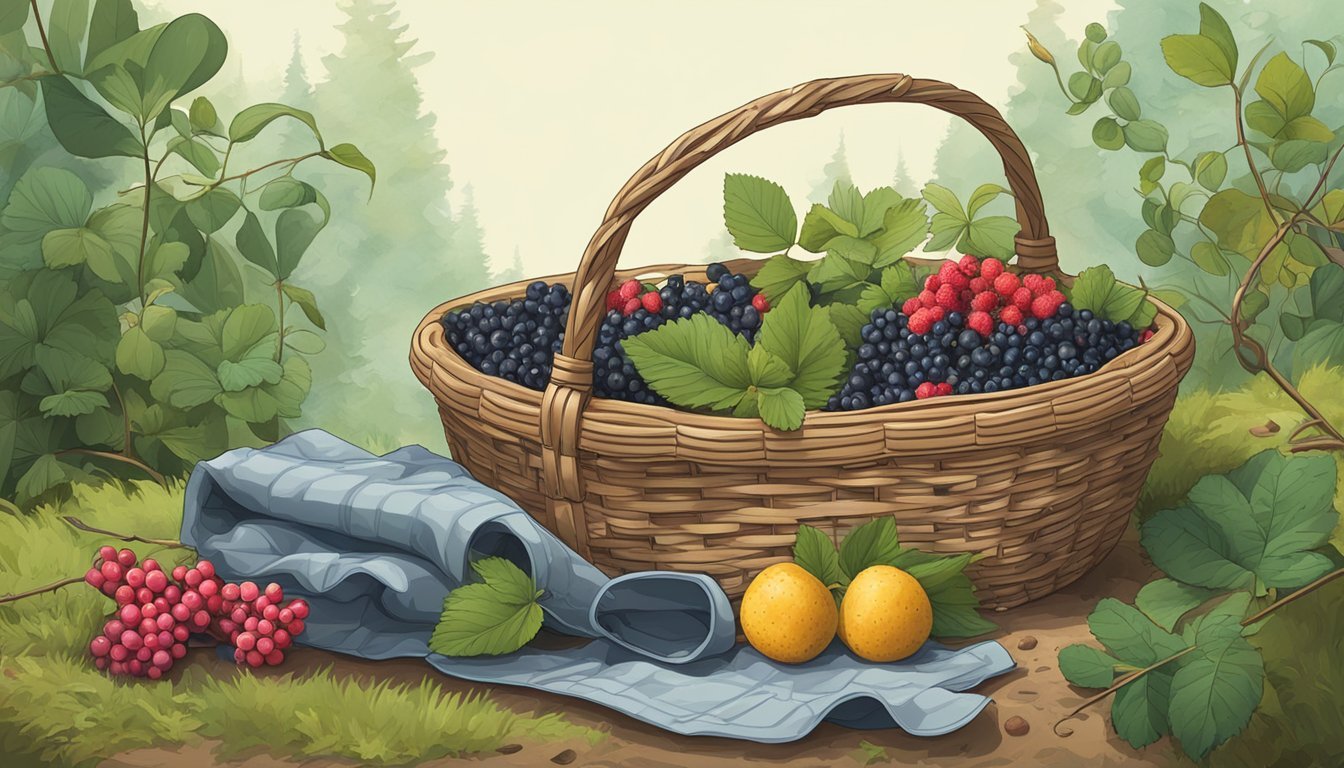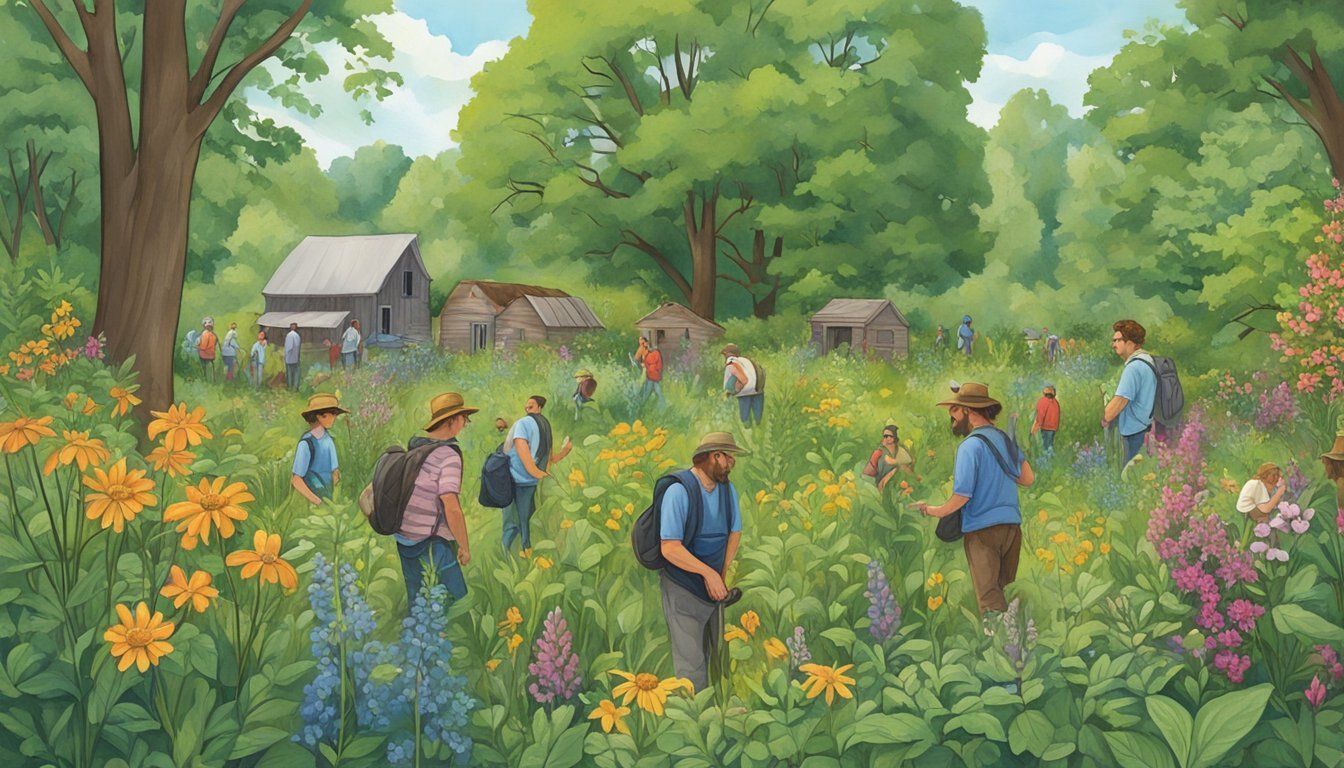Native Edible Plants in Ohio
A Guide to Foraging Local Delicacies
This Article is Part of Foraging Guide for All 50 US States
Ohio's landscape is a treasure trove of edible plants, providing an abundant source of nourishment that grows naturally across the state's diverse regions. Foraging, the practice of searching for and harvesting wild food resources, has been a part of human tradition for millennia, and it remains a valued skill for those interested in sustainable living and local food sources. The Buckeye State's rich soil and varied climate contribute to the growth of a wide variety of native edible plants, from leafy greens to high-energy tubers and nutritious nuts (how long do nuts last?).
Knowledge of these plants not only enriches one's appreciation for the state's natural resources but also offers an educational experience in identifying species that can add flavor and nutrition to meals. Those who forage in Ohio find themselves part of a community passionate about the environment and natural food. They discover species such as the pawpaw, with its custard-like fruit, or the bright, tart berries of the serviceberry tree; these are just a sampling of the flavors available to those who know where to look.
Safety and sustainability are at the forefront when foraging for edible plants. There is a need for careful identification to avoid toxic species, and practices such as ethical harvesting, which ensures that enough plants remain to propagate for future seasons, are vital. Ohio offers numerous educational resources and community groups for novice foragers, ensuring that the exploration of native edible plants is both a safe and rewarding endeavor.
Interested in Mushroom Hunting in Ohio?
Ohio's lush forests and diverse ecosystems make it a prime destination for mushroom hunting enthusiasts. From the elusive morel to the savory chanterelle, the state's woods are teeming with edible fungi. Join us as we explore the best spots, safety tips, and identification techniques for a successful mushroom hunting adventure.
👉 Guide on Mushroom Hunting in Ohio
Identifying Native Edible Plants
One can enjoy the rich tapestry of edible plants Ohio has to offer by learning to distinguish between nourishing flora and deleterious look-alikes. This critical skill not only enriches one's foraging experience but ensures safety.
Plant Identification Basics
When exploring Ohio's wild spaces, basic knowledge in plant identification is essential. It's important to observe leaf shapes, color, and growth patterns. A dependable guide will often highlight characteristics such as whether a plant has opposite or alternate leaves. For example, the pawpaw tree displays large, simple leaves in an alternate pattern, while the sassafras exhibits different leaf shapes on the same tree.
Common Edible Plant Profiles
Ohio is home to a variety of edible plants. Here are a few:
Pawpaw: Recognized by its large, drooping leaves and fruit which ripens to a yellowish-green in late summer.
Maple: Easily identified by its distinctive leaf shape; maple syrup (how long does maple syrup last?) can be harvested in late winter.
Dandelions: Ubiquitous with bright yellow flowers turning into white, fluffy seed heads.
High-bush Blueberries: Found in wetter soils, look for clusters of white bell-shaped flowers in spring and dark blue berries in summer.
Wild Strawberries: Small, white flowers give way to the familiar red berries in early summer.
Seasonal Foraging Guide
Timing is pivotal when foraging:
Summer: Berries such as high-bush blueberries and wild grapes are ripe for picking.
August: Look for pawpaw fruit.
Winter: Tap maple trees for sap to make syrup.
Toxic Look-Alikes to Avoid
Foragers must stay vigilant to avoid confusing edible plants with harmful ones. For example:
Poison Hemlock: Resembles wild carrot but can be distinguished by its purple-speckled stem.
Pokeweed: Features berries and foliage that are toxic unless properly processed.
Harvesting and Preservation Techniques
Proper harvesting enhances sustainability while preserving techniques extend the utility of forages.
Greenbrier: Harvest young shoots in spring; they can be eaten raw or cooked.
Ramps: These should be harvested conservatively, taking only a leaf or two from each plant to ensure regrowth.
Nutritional and Culinary Uses
Ohio's native plants offer a variety of edible parts that can be transformed into nutritious meals. This section addresses their preparation, health advantages, and the importance of sustainable foraging practices.
Edible Parts of Plants
Many plants native to Ohio provide edible parts, including berries, fruits, shoots, leaves, and roots. For example, the pawpaw yields a custardy fruit, and the ramps' broad leaves and bulbs are both edible. These parts vary in taste and nutritional content but often contain essential vitamins and minerals.
Preparing Wild Edibles in the Kitchen
When introducing wild edibles into the kitchen, they can complement or become the centerpiece of a recipe. Jerusalem artichoke tubers can be roasted or pureed into soups for a nutty flavor, and serviceberries can be used as substitutes for blueberries in recipes. It's essential to identify edibles correctly and prepare them safely to avoid toxicity.
Health Benefits of Wild Foods
Wild foods are often more nutrient-dense than their cultivated counterparts. They can support a healthy diet by providing a range of phytonutrients, antioxidants, and fibers. Traditional remedies also utilize these plants for their medicinal properties. For instance, dandelion leaves are known for their detoxifying effects.
Foraging Ethics and Sustainability
Foraging should be done responsibly to ensure the sustainability of native species. Harvesters must avoid over-picking and ensure that they leave enough plants for regeneration and the local wildlife. Ethical practices include taking only what is needed and respecting private property and conservation laws.
Wild Plant Nutrition and Herbal Medicine
Wild plants often play a dual role as food and medicine. Echinacea is notable for its immune-boosting properties, while black walnuts are rich in healthy fats and protein. Integrating these into one's diet can be done through simple teas or complex dishes that combine various wild edibles for a nutritious boost.
Ohio's Edible Plant Habitats
Ohio boasts a rich tapestry of habitats, each providing a unique set of edible plants that sustain both wildlife and foraging activities. From dense deciduous forests to sprawling meadows, Ohio's landscapes offer a varied menu for those knowledgeable about local flora.
Deciduous Forest Flora
Ohio's deciduous forests are dominated by oak and maple trees, under which a variety of edible plants thrive. Persimmon trees, with their sweet fruits, are a notable species found here. Plants like wild carrots and dandelions offer foragers a bounty beneath the canopy, contributing to the biodiversity and serving as food resources for wildlife.
Wetlands and Waterways Vegetation
Wetlands provide a habitat for species such as cattails and wild rice (how long does wild rice last?). These plants not only support the ecosystem's health but are tradition-rich food sources for people. The areas around waterways are particularly rich in biodiversity and are vital to the state's ecological balance.
Meadows and Fields Species
Vast meadows and open fields in Ohio present an array of edible species, including milkweed and wild carrots. These environments thrive with plant species that form the basis of the local food web, supporting a range of wildlife and pollinators while offering foragers plenty.
Urban and Suburban Foraging
Urban environments, including backyards and community gardens, have become unexpected sources of edibles like dandelions and milkweed. These plants sometimes go unnoticed, yet they provide accessible opportunities for urbanites to connect with natural food sources.
Threatened or Protected Species in Ohio
Within Ohio's diverse ecosystems, there are edible plants that are either threatened or protected. While these species contribute to the state's biodiversity, it is crucial to identify and forage them responsibly to ensure they continue to be a part of Ohio's habitats. Foragers must stay informed and respect conservation laws to protect these vital plants.
Regional Variations in Edible Flora
Ohio's terrain and climate lead to diverse edible plant species across its regions. The flora varies from the marsh marigold found in wet areas to fruit-bearing trees like apples and pawpaws that flourish in different parts of the state.
Northeast Ohio
Northeast Ohio's cooler climate is suitable for elderbushes, producing elderberries that ripen in late summer. Maple trees are also prevalent, with sap collected in early spring for maple syrup.
Southwest Ohio
This region enjoys a milder climate, favoring fruiting plants such as pawpaws and persimmons. Southwest Ohio's forested areas provide a habitat for black raspberries, often found in woodland borders.
Central Ohio
Central Ohio's varied landscape supports a mix of edible plants. The common apple tree thrives here along with wild grapes, which are typically found twining through trees and shrubs in open woodlands.
Southeastern Ohio
Southeastern Ohio's hilly terrain and rich soil encourage diverse flora. Ramps, a wild onion-like plant, grow abundantly in the shaded, moist soils of Appalachia. Pawpaws also find favorable conditions here.
Lake Erie Shoreline
The microclimate near the Lake Erie Shoreline supports unique species like the sand cherry. The area's sandy soil and proximity to water create a suitable environment for this hardy fruiting shrub.
Ohio Valley
In the fertile Ohio Valley, one can find cattails in wetlands, which provide starchy rhizomes and edible shoots. Black walnuts, known for their tough shells and rich flavor, are commonly found in the region's forests.
Legal Considerations for Foragers
Before foraging for edible plants in Ohio, it's crucial to understand the legal landscape. Individuals should be aware that regulations can be intricate and vary by locality.
Property Rights:
Public Lands: Foraging may be permissible, but specific regulations exist for state and national parks, forests, and wildlife areas. Always check local rules.
Private Property: Written permission from landowners is mandatory to forage on private land to avoid trespassing charges.
Foraging Laws:
Protected Species: Some plants are protected under state law. Foraging protected species can result in legal penalties.
Sustainability: Gatherers must adhere to sustainable practices to prevent ecological damage.
Key Concern Description Action Required Permissions Foraging generally requires explicit permission, especially on private lands. Obtain prior consent. Regulations Local and state regulations dictate what can be foraged and where. Research and comply with laws. Ethical Foraging Taking only what is needed and ensuring the survival of plant populations is a legal and ethical mandate. Practice sustainable harvesting.
Regardless of location, foragers should:
Clearly identify plant species to ensure they are not endangered or toxic.
Be informed about the local ecosystem to avoid disrupting wildlife habitats.
It is essential to regularly review the Ohio Department of Natural Resources or consult legal experts for updated information on foraging regulations. Remember, responsible foraging ensures the availability of native edible plants for future generations.
Tools and Equipment for Foraging
Essential tools and equipment can greatly enhance the foraging experience in Ohio’s diverse ecosystems, allowing for efficient and sustainable gathering of native edible plants.
Basic Gear
Foragers should have a foraging bag to collect their finds, ensuring it's lightweight and durable. A trowel is indispensable for digging roots, and should be compact and sturdy. Drying racks are vital for preserving herbs and flowers, keeping them ventilated and mold-free. For maintaining biodiversity, seed saving equipment such as envelopes and markers are necessary to track and plant seeds for future growth.
Foraging Bag: Lightweight, durable
Trowel: Compact, sturdy
Drying Racks: Promote ventilation, reduce mold risk
Seed Saving Equipment: Envelopes, markers
Advanced Tools for Experienced Foragers
Experienced foragers may invest in specialized knives for harvesting, and GPS devices for tracking their favorite foraging spots. They might also use soil testing kits to determine the health of the areas they forage in.
Specialized Knives: Precise cutting, ergonomic design
GPS Devices: Location tracking, marking spots
Soil Testing Kits: Analyze soil health, promote sustainable foraging
Foraging Apps and Field Guides
To aid identification and ensure only edible species are gathered, foragers utilize mobile apps and field guides. These tools often feature photos, descriptions, and can sometimes even help with GPS mapping of found items.
Mobile Apps: Photos, edible species identification
Field Guides: Detailed descriptions, plant habitat information
Safety Gear and First Aid
Safety gear such as gloves and boots protect against thorns and poisonous plants, while a well-stocked first aid kit is crucial for addressing any injuries or allergic reactions immediately.
Gloves: Protection from thorns, plants
Boots: Sturdy, protect against uneven terrain
First Aid Kit: Treat injuries, allergic reactions quickly
Connecting with Local Foraging Communities
Connecting with local foraging communities can enhance both knowledge and experience. Ohio offers various channels to engage with fellow enthusiasts, gather local expertise, and ensure sustainable practices.
Foraging Workshops and Groups
Community centers and nature groups across Ohio frequently host foraging workshops. These workshops provide hands-on experience and foster local knowledge. The Gorman Nature Center and Cleveland Metroparks are examples where one can join scheduled events. Social media platforms like Facebook also host groups such as Ohio Foragers, where members arrange meetups and exchange information.
Foraging with Expert Guides
Working with expert guides can be invaluable, especially for beginners. These mentors share insights on identifying, harvesting, and preparing native edibles. The Ohio Mushroom Society, for example, pairs novices with seasoned foragers, providing mentorship in mycological pursuits.
Educational Resources at Ohio University
Ohio University offers educational resources and programs focused on native flora. They conduct seminars and discussions led by conservation experts to teach ethical foraging. Their library provides access to a wide range of literature on edible plants indigenous to Ohio.
Sharing Foraged Harvests
Sharing of harvests plays a crucial role in Ohio's foraging communities. Excess yields often find their way into community events or are traded among group members. This practice not only promotes community bonds but also encourages a culture of generosity and reciprocity.
Conservation and Ethical Foraging Practices
Conservation is the cornerstone of foraging. Ohio's foraging communities are dedicated to teaching and following ethical harvest principles. They emphasize the importance of sustainable practices such as taking only what is needed and leaving no trace. They also strive to protect endangered species and their habitats.
Additional Resources
Exploring the world of foraging for native edible plants in Ohio can be enriched with a variety of educational tools and community support. This section provides a curated list of resources ranging from comprehensive literature to interactive online platforms and vital regulatory information for responsible foraging.
Recommended Books on Foraging
For enthusiasts seeking authoritative literature on foraging, the following field guides and reference books are indispensable:
"Edible Wild Plants: Wild Foods From Dirt To Plate" by John Kallas - A detailed guide to identifying, harvesting, and preparing edible wild plants.
"Midwest Foraging" by Lisa M. Rose - This field guide specifically caters to the Midwestern flora and is ideal for Ohio foragers.
Online Forums and Communities
Online platforms offer a plethora of information, courses, webinars, and forums where gardeners and foragers can connect and share knowledge:
Foraging Ohio (Facebook Group) - A community for Ohio foragers to discuss plants and share experiences.
The Forager's Path (Online Courses) - Offers online courses and webinars on foraging and herbal medicine.
Local Botanical Gardens and Arboreta
Botanical gardens and arboreta provide educational opportunities for those interested in native plants and landscaping, such as:
Holden Arboretum - Not only a visual feast but also a place for learning about native Ohio plants.
Franklin Park Conservatory and Botanical Gardens - Offers workshops that sometimes include foraging topics.
Conservation Organizations
Engaging with native plant societies and environmental groups is beneficial to learn more about conservation and sustainable practices:
Ohio Native Plant Society - Focuses on the appreciation and conservation of Ohio's native plants and plant communities.
The Nature Conservancy in Ohio - Works on habitat conservation and offers resources about native landscapes.
State and National Park Regulations
It is crucial for foragers to familiarize themselves with the regulations of state and national parks to ensure sustainable and legal foraging practices:
Ohio Department of Natural Resources - Provides information on regulations within Ohio state parks.
U.S. National Park Service - Before foraging in national parks, one must check for specific regulations and obtain necessary permits.
Conclusion
Ohio boasts a rich assortment of native edible plants, contributing to both culinary diversity and local ecosystems. Pawpaw trees (Asimina triloba) grace the state with America's largest native fruit, offering a tropical taste. The ground yields ramps (Allium tricoccum), a wild onion with a devoted springtime following.
Berries like the Rubus genus, including blackberries and raspberries, provide seasonal foraging opportunities. It's essential for foragers to properly identify these plants, as some have look-alikes that are not edible.
Further adding to Ohio's natural larder are nut-bearing trees, such as black walnut (Juglans nigra) and hickory (Carya spp.), which offer nutrient-rich foraging options. Herbs like wild mint (Mentha arvensis) can be spotted along streams, enhancing culinary creations with their fresh, pungent flavors.
The state extends a unique invitation for residents and visitors to engage responsibly with the land. Enthusiasts are encouraged to learn about and experience these edible treasures, enriching their diets and fostering a connection with Ohio’s natural heritage. While foraging, they must adhere to sustainable practices:
Harvest selectively
Leave no trace
Respect wildlife habitats
Ohio's native plant species are not only significant gastronomically but ecologically, playing vital roles in their habitats. They can enhance gardens, offering benefits for local wildlife and pollinators as well. With knowledge and respect, Ohioans can savor and protect these indigenous flavors for future generations.








